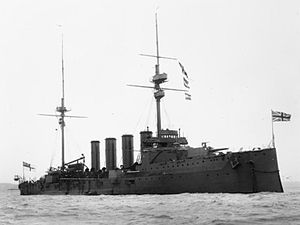Duke of Edinburgh-class cruiser

Duke of Edinburgh at anchor
|
|
| Class overview | |
|---|---|
| Name: | Duke of Edinburgh |
| Operators: |
|
| Preceded by: | Devonshire class |
| Succeeded by: | Warrior class |
| Cost: | £1,193,414–£1,201,687 |
| Built: | 1903–1906 |
| In service: | 1906–1919 |
| Completed: | 2 |
| Lost: | 1 |
| Scrapped: | 1 |
| General characteristics | |
| Type: | Armoured cruiser |
| Displacement: | 12,590 long tons (12,790 t) |
| Length: | 505 ft 6 in (154.08 m) (o/a) |
| Beam: | 73 ft 6 in (22.4 m) |
| Draught: | 27 ft 6 in (8.4 m) |
| Installed power: |
|
| Propulsion: |
|
| Speed: | 23 knots (43 km/h; 26 mph) |
| Range: | 8,130 nmi (15,060 km; 9,360 mi) at 10 knots (19 km/h; 12 mph) |
| Complement: | 769 |
| Armament: |
|
| Armour: |
|
The Duke of Edinburgh-class cruiser was a class of two armoured cruisers built for the Royal Navy in the first decade of the 20th century. They were the first British armoured cruisers designed to work with the battlefleet rather than protect merchant shipping. After commissioning, they were assigned to the Atlantic, Channel and Home Fleets until 1913 when they were transferred to the Mediterranean Fleet. After the start of World War I in August 1914, the sister ships participated in the pursuit of the German battlecruiser SMS Goeben and light cruiser SMS Breslau. After the German ships reached their refuge in Ottoman Turkey, the ships were ordered to the Red Sea for convoy escort duties. They captured three German merchant ships before they returned to home at the end of the year.
The sisters participated in the Battle of Jutland in May 1916 where Black Prince was sunk with all hands. Duke of Edinburgh spent the next year on blockade duties in the North Sea before she was transferred to the Atlantic Ocean on convoy escort duties for the rest of the war. She was sold for scrap in 1920.
After the preceding Devonshire class, the Royal Navy rethought how it planned to use its armoured cruisers. It decided that they were going to form a fast wing of the battlefleet which meant that they required heavier armour and armament to fight their counterparts in opposing fleets and thus larger and more expensive. Two armoured cruisers were planned for the 1902–1903 Naval Programme and the newly appointed Director of Naval Construction, Philip Watts designed what naval historian Oscar Parkes called: "cruiser editions of the King Edward VII-class battleships". In these, his first design, he perpetuated the worst feature of the designs by his predecessor, Sir William White, by placing the secondary armament of six-inch (150 mm) guns in embrasures a deck below the main armament which meant that the guns were inoperable in anything more than a dead calm sea. A solution for this problem was offered after construction began when Watts learned that the ships would be lighter than expected and that weight would be available to replace the six-inch guns with 7.5-inch (190 mm) guns raised to the same deck as the main armament. The change would cost a total of £398,000 for the two ships, far too expensive for the Board of Admiralty, so it was rejected on 30 March 1904.
...
Wikipedia
